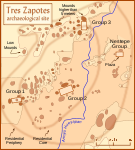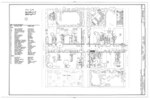Who Draws Up Site Plans


A site plan or a plot programme is a type of drawing used past architects, landscape architects, urban planners, and engineers which shows existing and proposed weather condition for a given surface area, typically a parcel of land which is to be modified. Sites plan typically show buildings, roads, sidewalks and paths/trails, parking, drainage facilities, germ-free sewer lines, water lines, lighting, and landscaping and garden elements.[1]
Such a plan of a site is a "graphic representation of the organization of buildings, parking, drives, landscaping and whatever other structure that is part of a development projection".[2]
A site plan is a "set of construction drawings that a architect or contractor uses to make improvements to a property. Counties can employ the site programme to verify that evolution codes are beingness met and every bit a historical resource. Site plans are often prepared by a blueprint consultant who must be either a licensed engineer, architect, landscape architect or land surveyor".[iii]
Site plans includes site analysis, building elements, and planning of various types including transportation and urban. An example of a site plan is the plan for Indianapolis[4] by Alexander Ralston in 1821.
The specific objects and relations are shown are dependent on the purpose for creating the plot program, but typically incorporate: retained and proposed buildings, mural elements, in a higher place-basis features and obstructions, major infrastructure routes, and critical legal considerations such as holding boundaries, setbacks, and rights of way.
Site plan topics [edit]
Site assay [edit]
Site analysis is an inventory completed every bit a preparatory step to site planning, a form of urban planning which involves enquiry, analysis, and synthesis. It primarily deals with bones information as it relates to a specific site. The topic itself branches into the boundaries of architecture, mural architecture, engineering, economics, and urban planning. Site analysis is an chemical element in site planning and design. Kevin A. Lynch, an urban planner developed an eight cycle footstep process of site pattern, in which the second step is site analysis, the focus of this department.
When analyzing a potential site for development, the condition quo of the site should exist analyzed and mapped. This includes just is non express to:
- The location of the plot
- Topography, including information about gradient, soils, hydrology, vegetation, orientation
- Existing buildings
- Roads and traffic
- Public facilities and utilities, including h2o, sewer, and power lines
- Related laws, regulation, codes, and policies
By determining areas that are poor for development (such as floodplains or steep slopes) and amend for development, the planner or architect can determine the optimal location for different functions or structures and create a design that works within the infinite.
Site plan building blocks [edit]

A site plan is a elevation view, bird's eye view of a holding that is drawn to scale. A site plan tin evidence:
- property lines
- outline of existing and proposed buildings and structures
- altitude between buildings
- altitude between buildings and property lines (setbacks)
- parking lots, indicating parking spaces
- driveways
- surrounding streets
- landscaped areas
- easements
- ground sign location
- utilities
Site planning [edit]
Site planning in landscape architecture and architecture refers to the organizational stage of the landscape design process. It involves the arrangement of land utilize zoning, access, apportionment, privacy, security, shelter, land drainage, and other factors. Site planning includes the arrangement of buildings, roadways, utilities, landscape elements, topography, water features, and vegetation to achieve the desired site.[5] [6]
In urban planning, site planning is done by city planners to develop a clear plan/design of what the city planners want for a customs.[7] For example, in a participatory planning procedure, community members would make claims of renovations and improvements that demand to exist done in their community. So the community developers volition come upwardly with a way to meet the customs members' demand, which is washed by creating a site program. With a limited upkeep, planners take to be smart and creative about their designs.[7] Planners must take into consideration not only heights of buildings, traffic flows, open spaces, parking for cars/bikes, only likewise the projection's potential impact to the stakeholders involved.[6] All these actions of creating a site programme is referred to as site planning.
Transportation planning [edit]
Transportation planning is the field involved with the siting of transportation facilities (generally streets, highways, sidewalks, bike lanes and public ship lines). Transportation planning historically has followed the rational planning model of defining goals and objectives, identifying issues, generating alternatives, evaluating alternatives, and developing the plan. Other models for planning include rational role player, satisficing, incremental planning, organizational process, and political bargaining. All the same, planners are increasingly expected to adopt a multi-disciplinary approach, especially due to the rising importance of environmentalism. For instance, the utilise of behavioral psychology to persuade drivers to abandon their automobiles and use public transport instead. The role of the transport planner is shifting from technical analysis to promoting sustainability through integrated transport policies.[8]
Urban planning [edit]
Urban, city, and boondocks planning explores a very wide range of aspects of the built and social environments of places. Regional planning deals with a still larger environment, at a less detailed level. Based upon the origins of urban planning from the Roman (pre-Dark Ages) era, the current discipline revisits the synergy of the disciplines of urban planning, architecture and landscape compages.
Examples [edit]
-

Lockefield Gardens - site plan.
-

WTC Building Organisation and Site Plan.
-

Site plan of Tres Zapotes
-

Site Plan of the Lincoln Habitation Site
-

Rendered site plan by Louis-Pierre Baltard
See as well [edit]
- Programme (drawing)
- Archaeological plan
- Floor plan
- Technical drawing
- Architectural drawing
- Engineering cartoon
- Mural design
- Site Waste product Management Plans Regulations 2008
References [edit]
- ^ "Department of Building and Development Land Development". Loudoun County Government. Archived from the original on May 27, 2010. Retrieved eleven Feb 2009.
- ^ Oftentimes Asked Questions [ expressionless link ] Miami Township. Accessed 11 Feb 2009.
- ^ Site Planning Process Chesterfield Canton, Virginia Planning Department. Accessed eleven February 2009. Archived March 29, 2009, at the Wayback Motorcar
- ^ "Alexander Ralston's 1821 Plan for Indianapolis | The Cultural Landscape Foundation". tclf.org . Retrieved 2020-04-28 .
- ^ "Site planning | landscaping". Encyclopedia Britannica . Retrieved 2020-03-28 .
- ^ a b Tyler, Norman, Robert Grand. Ward (2011). Planning and community development A guide for the 21st century. Norton & Co.
- ^ a b McBride, Steven. "Site Planning and Design". [ permanent dead link ]
- ^ Southern, A. (2006), Modern-day transport planners need to be both technically proficient and politically astute, Local Transport Today, no. 448, 27 July 2005.
External links [edit]
| | Wikimedia Commons has media related to Site plans. |
- SCHWARZPLAN.european union - Download archive for site plans based on data past OpenStreetMap.org
Source: https://en.wikipedia.org/wiki/Site_plan
Post a Comment for "Who Draws Up Site Plans"